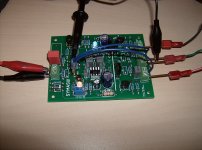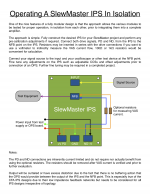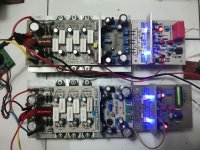Btw, does anyone know what the power dissipation is in the output pairs? How much of the power is dissipated as heat?
If we know the % of the input power that goes to heat we can calculate the heatsink needed for that input power.
Not sure if the efficiency will remain the same or not with less or more input power.
OS: I wonder if it's possible to simulate this?
If we know the dissipation we can check the datasheet what the max junction temperature would be for this ammount of power dissipation, depending on the used transistor.
Thermal resistances can be quite easily found in datasheets.So we can then calculate what heatsink is needed, or how much input power a certain heatsink can take.
I haven't seen any calculations, are you all guessing?
If I'm not mistaken, more output transistors = lower Rth
thermal resistance (for junction to case & thermal (insulation) pad) can be divide by the number of output trannies, same for the total power dissipation. The heatsink still needs to be able to get rid of the full power ofcourse.
More transistors would mean that we can survive higher junction temperature as well.
I think it might be cheaper to add more output pairs then upgrade the heatsink.. and certainly take less place
I'm considering to start with 2 channels, but if all would go right I might consider 6 channels, as an (awesome) surround amp.. splitting the same power over 6 channels.. But then heatsink size does play a role ofcourse. Although that is far from sure, I'd rather take it into account already.
Keep up the good work guys
I put up a calculation of the required heatsink in our local forum.
SLEWMASTER Build
If any a constructive comment is always welcome...
I put up a calculation of the required heatsink in our local forum.
SLEWMASTER Build
If any a constructive comment is always welcome...
Jaagut
i see your job in this forum
very god job
what is the voltage ripple p-p in ~ mv of PSU static mode?
regards Nikos
Hum... not always so simple. Imagine you are using laterals.If I'm not mistaken, more output transistors = lower Rth
thermal resistance (for junction to case & thermal (insulation) pad) can be divide by the number of output trannies, same for the total power dissipation. The heatsink still needs to be able to get rid of the full power ofcourse.
More transistors would mean that we can survive higher junction temperature as well.
One of the advantage of those devices is they have a current where they are thermally flat. Usually around 150mA. It is the point where they sound the best too.
So each time you double the number of devices, you will like to double the quiescent current.
Jaagut
i see your job in this forum
very god job
what is the voltage ripple p-p in ~ mv of PSU static mode?
regards Nikos
Hi Nico,
I have to build the actual PSU yet.
So until then, I have to wait for the actual measurements...
btw, thanks for the appreciation...
Last edited:
Beautiful work ,congratulations!Got a Symasui board stuffed today for QC check. Looks good so far, just need to get an appropriate op-amp for the servo tomorrow.
Regards.
Thimios.
Terry,
Did you get your tube hybrid working before you left on vaca??
Hi Carl,
No, unfortunately. The IPS works stand alone, but when hooked up to the ops it goes crazy. Valery is working on a solution.
Thanks Jason.
The Low TIM hybrid IPS works using those rules. However it goes nuts once it is attached to the OPS. It is possible that I have done something wrong but I have checked pretty closely. Not sure why it works with Valery's ops and not the Slewmaster but there is something going on.
The Low TIM hybrid IPS works using those rules. However it goes nuts once it is attached to the OPS. It is possible that I have done something wrong but I have checked pretty closely. Not sure why it works with Valery's ops and not the Slewmaster but there is something going on.
Sounds like some kind if instability going on between the IPS and OPS. I haven't looked too closely at Valery's IPS but I'll have a peek and see if just a compensation change might bring it into line. Of course, Valery's knows his IPS better than I so any suggestion he had supersedes mine.
@Valery - If you could benefit from a SlewMaster OPS board please PM me.
@Valery - If you could benefit from a SlewMaster OPS board please PM me.
Last edited:
Updated
Terry, Jason and All - here we go:
Redesigned compensation - the one I could not break
Terry, please use the "lamp tester" in the beginning. I'm sure it's going to be fine this time, but you know... some extra caution will not be excessive.
Jason, your possible additional ideas are always appreciated.
Cheers,
Valery
Terry, Jason and All - here we go:
Redesigned compensation - the one I could not break
Terry, please use the "lamp tester" in the beginning. I'm sure it's going to be fine this time, but you know... some extra caution will not be excessive.
Jason, your possible additional ideas are always appreciated.
Cheers,
Valery
How about some more listening comparisons between VFA and CFA amps?
THx-RNMarsh
Why bother, if you level them up they all sounds the same.
- Home
- Amplifiers
- Solid State
- Slewmaster - CFA vs. VFA "Rumble"


